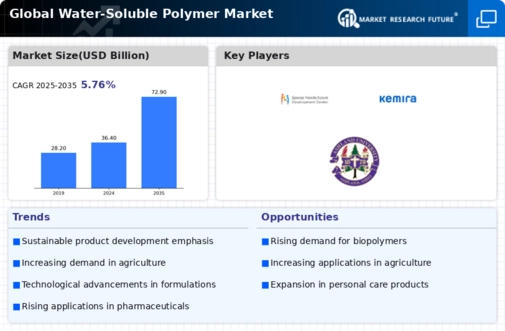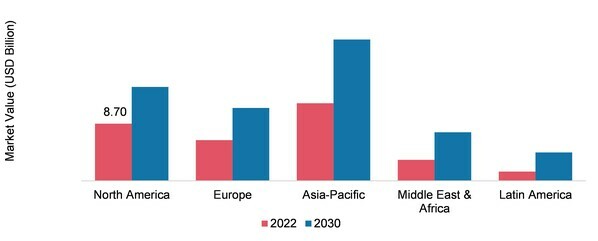Market Trends
Introduction
Water-soluble polymers in 2023 will be a result of the combined effects of several macro-economic factors, including technological changes, regulations, and changing consumer habits. In the field of polymer chemistry, there are new trends in the development of the properties of products, and new possibilities for using them in various industries, from agriculture to pharmaceuticals. The introduction of stricter regulations in the field of the environment will push manufacturers to take a sustainable path and develop green products, which will affect the structure of the product range. Also, a growing demand for biodegradable and non-toxic materials will affect the market, and this will force the players to change their strategies. In order to understand the future of the market, it is necessary to know these changes and trends, which will be accompanied by an increase in competition and the speed of change.
Top Trends
-
Sustainability Initiatives
In the market for water-soluble polymers, the demand for sustainable products is reshaping the industry. Regulations and subsidies also promote the use of eco-friendly materials. The European Green Deal, for example, is designed to reduce the amount of plastic waste, thereby increasing the demand for biodegradable alternatives. This trend is expected to benefit the companies that are taking a stand for sustainable development, whose brand loyalty and market share will increase. -
Technological Advancements
A number of developments in the chemistry of polymers and their processing have resulted in the development of high-performance water-soluble polymers. Companies like Ashland are able to take advantage of these developments to enhance the performance of their products. The introduction of “smart” polymers that react to external stimuli is also gaining momentum. This is a trend that will lead to new applications in a variety of industries, including agriculture and pharmaceuticals. -
Rising Demand in Agriculture
The use of water-soluble polymers in agriculture has been increasing, mainly for soil conditioning and the controlled release of fertilizers. Leaders like SNF develop specific products to improve the yield and water retention of the soil. According to industry data, the use of these polymers can improve the soil by up to 30 per cent. This trend is expected to lead to significant growth in the agricultural market. -
Expansion in Personal Care Products
Water-soluble polymers are increasingly used in cosmetic products to improve the texture and stability of the product. Companies like AkzoNobel are constantly innovating to meet the demand for products with multiple properties. These water-soluble polymers are expected to grow by 15% in the cosmetics industry by 2025. This trend will lead to new product lines and increased competition among the companies. -
Increased Regulatory Scrutiny
Authorities are imposing restrictions on the use of chemicals, which has a direct impact on the water-soluble polymer market. For example, the REACH regulation in Europe requires thorough risk assessment. In order to comply with this regulation, companies need to adapt their formulations, which can lead to higher R&D costs. This trend may result in market concentration as smaller players are unable to meet these demands. -
Growth in Oil and Gas Applications
Oil and gas extraction processes are increasingly using water-soluble polymers, especially in hydraulic fracturing. Firms like Arkema S.A. develop polymers which modify the properties of the fluids. As energy companies are looking to improve their efficiency and reduce their impact on the environment, demand for these products is expected to rise. This trend may lead to strategic alliances between the polymer producers and the energy companies. -
Emerging Markets Expansion
In the course of the industrialization and urbanization of the new countries, a rapid increase in the consumption of soluble polymers is being experienced. To take advantage of this growth, Kemira is concentrating on the markets of Asia-Pacific and Latin America. By the year 2025, according to estimates, the consumption of polymers in these regions will increase by 20 percent. This growth creates opportunities for new players to enter the market and for existing players to expand their market position. -
Focus on Customization
It is therefore becoming increasingly common to design water-soluble polymers to suit the specific needs of the industry. Companies such as the Dow Corning Company offer tailor-made solutions for a wide variety of applications. This not only enhances the performance of the products but also increases customer loyalty. In a highly competitive market, the ability to provide a bespoke service is expected to set the company apart. -
Integration of Digital Technologies
The use of digital technology in production is transforming the water-soluble polymer market. The use of the Internet of Things and artificial intelligence is used to optimize production and supply chains. This can lead to a reduction in costs and an increase in product quality. Those who adopt this technology will gain a competitive advantage. -
Increased Collaboration and Partnerships
Polymer producers and end users are increasingly collaborating to drive innovation. Strategic alliances are forming between the likes of Mitsubishi, DIC and others to develop new products. These alliances are sharing knowledge and accelerating product development. Future collaborations will bring breakthroughs in polymer applications across industries.
Conclusion: Navigating Competitive Waters in 2023
The water-soluble polymer market will be highly competitive and highly fragmented in 2023. The regional trends show a growing demand for sustainable solutions, which forces the suppliers to develop and adapt their products. The large players have the advantage of their wide distribution network and brand loyalty, while the newcomers have the advantage of agility and newer technology. Artificial intelligence, automation and a focus on sustainable development will be the decisive factors for market leaders. Strategically, the ability to be flexible and responsive to market changes will be decisive for the success of the companies.







Leave a Comment